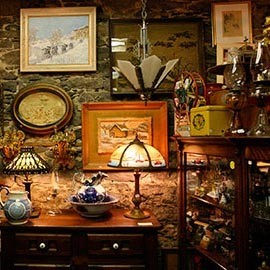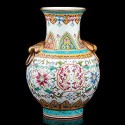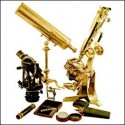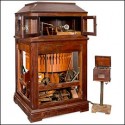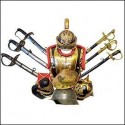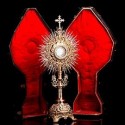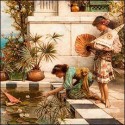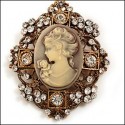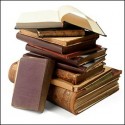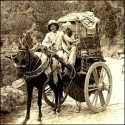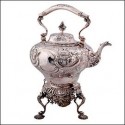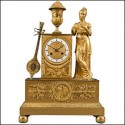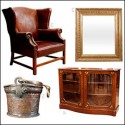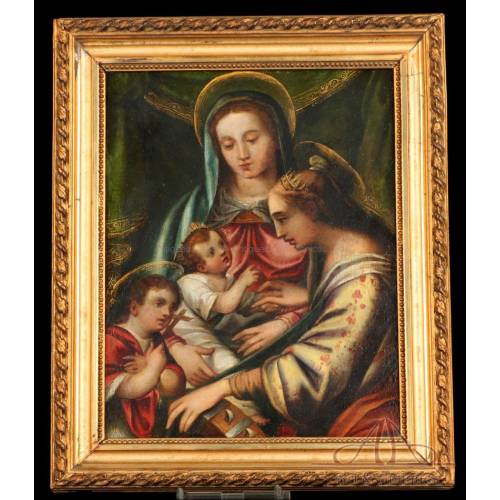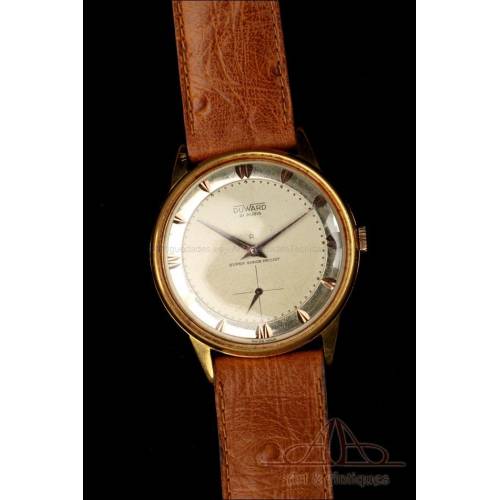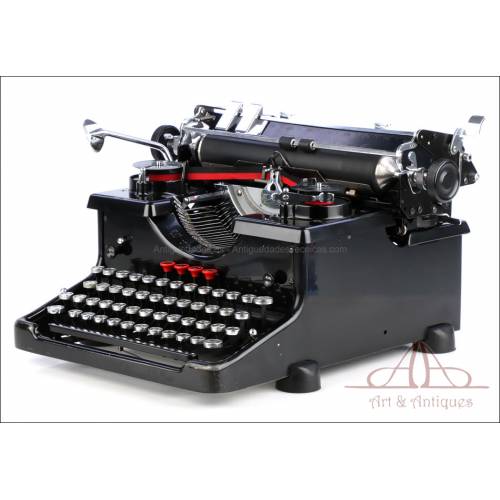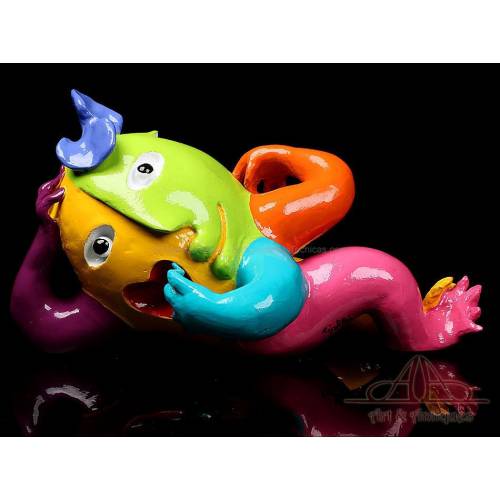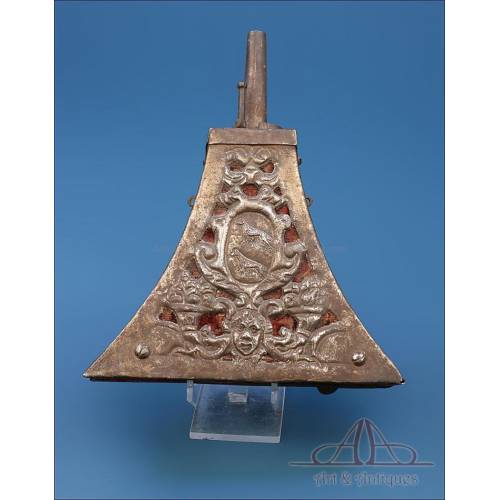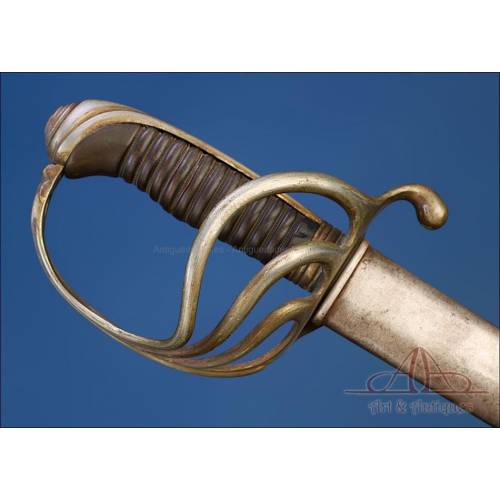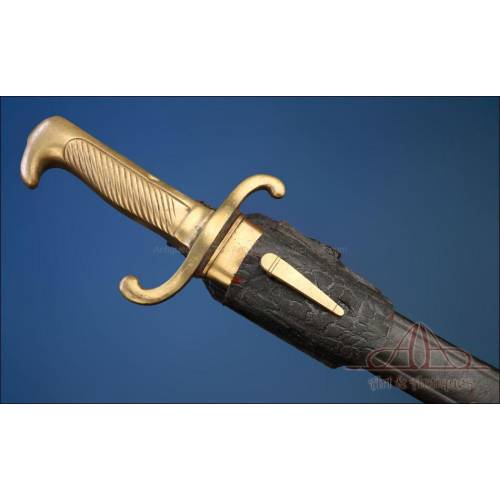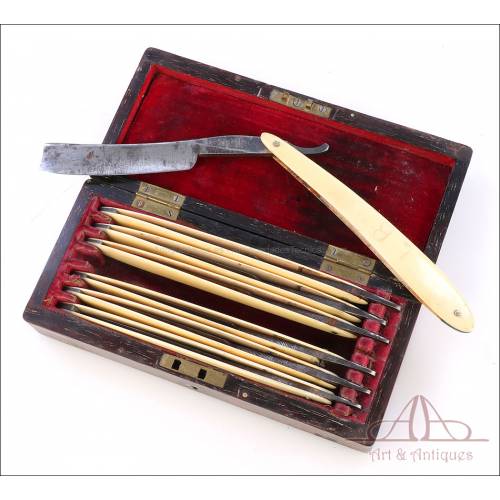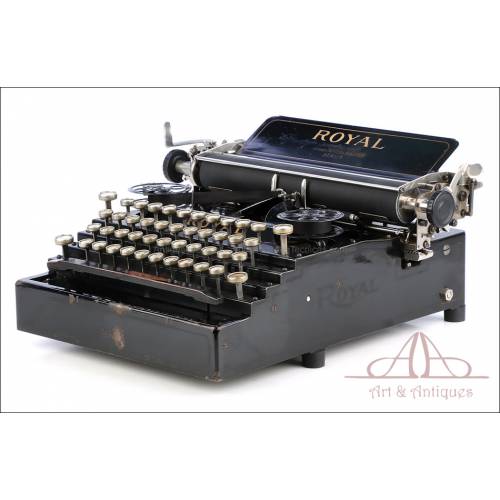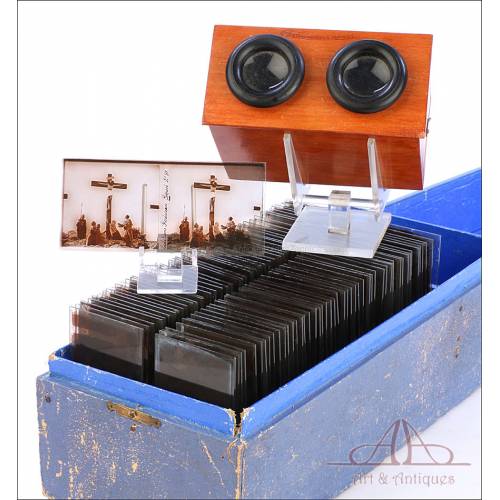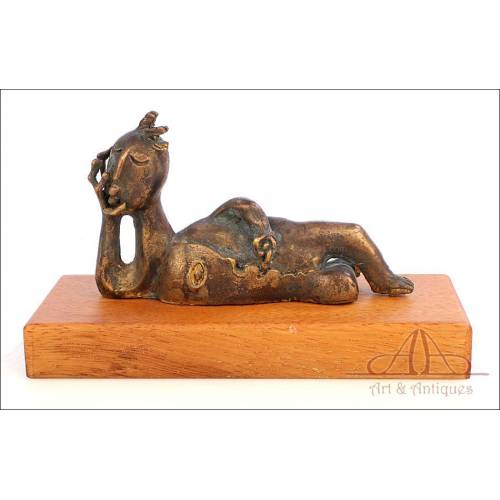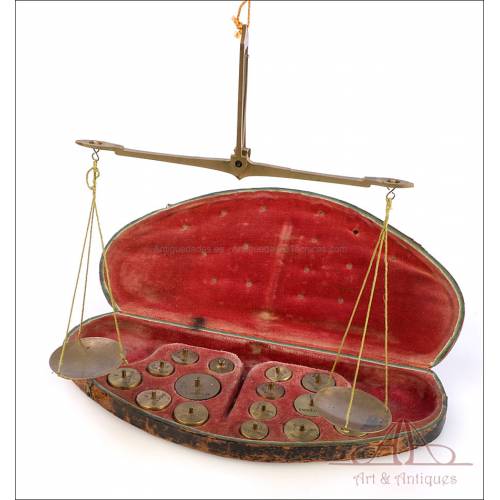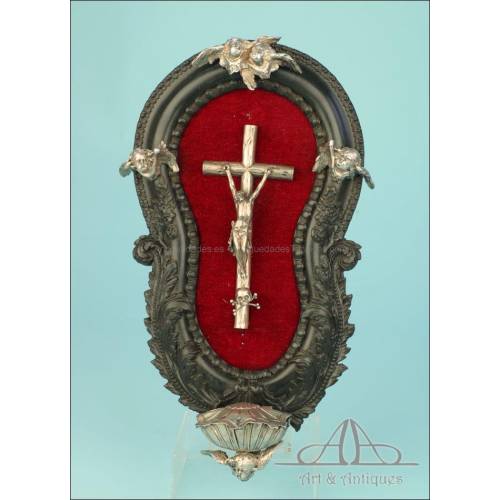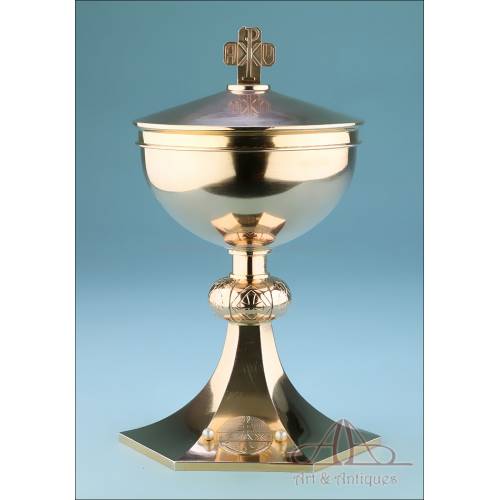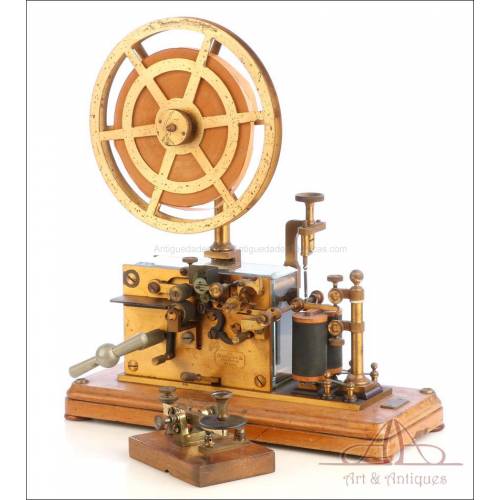Antiques
Wide range of antiques
Our page has a wide catalogue of antiques that is constantly renewed, and this makes us one of the best in the market for antique parts. Our range of objects is very varied. All categories of our shop are divided into sections for easy access (e.g. 'antique clocks'). You only have to select the category of your interest to...
Wide range of antiques
Our page has a wide catalogue of antiques that is constantly renewed, and this makes us one of the best in the market for antique parts. Our range of objects is very varied. All categories of our shop are divided into sections for easy access (e.g. 'antique clocks'). You only have to select the category of your interest to be able to access it. In each of the categories and subcategories you will find the antiques that are available for sale at the moment, and which we are constantly updating. Visit us often to know the last news of our shop.
An accessible catalogue to facilitate your search
All the old pieces that show their price, at the bottom of the product, are available for sale. In the left column you can filter the available antiques, or even debug the existing ones according to the price range you are looking for. In short, the articles can be sorted by name, by price, or also by reference number. You can also visit the section of antiques sold. Furthermore, we have a small database for cataloguing and enjoying the best pieces we have sold, which you can access at any time, and which you can access through "sold pieces".
In case of doubt or if you don't find what you're looking for, contact us!
We are at your disposal to clarify any doubt or query about our website or about any specific piece. All the antique pieces that you will see here are described and photographed to represent their state up to the most rigorous detail. In fact, some pieces are also available with photographs in 360º, with videos, or even with both. If you find an old piece that has not been photographed yet, or you need to know more details about a certain product, just ask us.
And finally, we wish you a happy shopping and stay in Antiques.es.
Subcategories
Chinese Antiques
... and oriental antiques
Original Chinese antiquities until 1945 from one of the dynasties of monarchs who ruled China, Ming, Qing, until 1911 or from the Republic period, from 1912 to 1949. Mainly paintings and calligraphy, sculptures and wood carvings, jade and lacquer, as well as porcelain. Ancient Chinese art followed the ancestral tradition and aims to express natural beauty, philosophical and religious currents.
Antique objects from China (and also from other Asian countries) are in fashion. A good proof of this is the great amount of pieces that can be found in auctions and shops of the sector. In fact, many interior designers use them for their work. The ancient Chinese were accomplished artists when it came to creating all kinds of objects, some of them commonly used as plates or boxes.
Beautiful objects at all kinds of prices
On the other hand, there is a legend that Chinese antiquities are expensive. Although it is true that some pieces have very high prices, there are precious objects coming from the Asian giant at very good prices. This is not the place to make a list of them but we will say that, saving pieces of great value, we can find vases, plates and other objects for an affordable amount to any pocket. And this in spite of the fact that, in many cases, they have more than a hundred years of history. It is enough to visit any of the many shops specialized in this type of oriental antiques to get a pleasant surprise and return home with a beautiful decorative piece.
Types of Chinese antiques
The objects from China that we can find are of various kinds. On the one hand, we have the plates, generally painted by hand and of an extraordinary artistic quality, some real masterful drawing. There are also the trays, about which the same can be said. But perhaps the best known Chinese antiques are the vases. Leaving aside those of past dynasties, which are within the reach of very few, we can find beautiful pieces of this type at very good prices and also decorated by hand with great skill. But we can also find many other types of objects such as clocks, cigarette cases, fans or boxes. On the other hand, many of these objects have as raw material the famous Chinese porcelain, a reference in the world of oriental antiques. No wonder, it was the ancient inhabitants of the Asian giant who began to use it for their decorative pieces. Chinese porcelain has achieved worldwide fame. In short, Chinese antiques have a place everywhere because they match harmoniously with all types of decoration and, especially if we talk about Chinese porcelain, give a touch of indisputable distinction.
Scientific Antiques
The science of our ancestors
Since ancient times, human beings, thanks to their curious nature par excellence, have wondered about the origin of the most insignificant things. The thirst for knowledge gave way, century after century and in different civilizations, to complex studies and trials to test different theories using scientific instruments and calculations. With the appearance of the scientific method and its popularization by philosophers and scientists, steps were established for the affirmation of different theories: observation, formulation of hypotheses and experimentation. Thanks to the inventiveness of the human being, different study tools were created out of necessity, which facilitated the work of both scientists and teachers. These study instruments are currently classified as precious scientific antiques, witnesses of victories and defeats in the field of scientific study.
If there is one type of fascinating antiques, it is precisely the scientific antiques. Devices enlightened by extraordinary minds that have allowed the development of humanity and have provided us with enviable standards of living. The scientific antiquities are among the most coveted objects by scholars because they help to tell an orderly and coherent story about scientific progress. The objects on display here represent the spearhead of a particular moment in history, as well as shouting out our successes and whispering our mistakes.
The objects on display here represent the spearhead of a particular moment in history.
Antique, unique and functional pieces
For lovers of scientific antiques we have different tools of scientific and educational character from several different eras. These tools are perfect to complete your antiques collection or to satisfy your curiosity as a science lover and learn about the instruments that our ancestors used to immerse yourself in this fascinating world.
The antiques that make up this section
You will be able to find all our scientific antiques classified in different categories in order to find those that interest you the most:
- - Antique microscopes: we have a wide variety of binocular, monocular, drum, dissecting or botanical microscopes among others. In this section you can find pieces of more than 200 years old in perfect condition.
- - Medical and pharmacy antiques: if you are looking for authentic antique pieces of medical instruments, we invite you to check our surgeon's cases, dentist's cases, pharmacy jars, precision scales and trumpets.
- - Surveying and ancient engineering: the first scientific representations of the earth's surface were possible thanks to various measuring instruments such as ancient theodolites, topographic levels or pantographs that, although they may seem rudimentary, have transcended in time to the present day.
- - Laboratory antiques: the tools used in teaching and scientific research have evolved over time. In our store you will find various scientific laboratory antiques such as balances or antique polarimeters among others.
- - Optical antiques: the optical sector offers us really interesting instruments used by navigators or astronomers to carry out their studies or to find the course on a trip. We have several telescopes, spotting scopes, stereoscopes or sextants in perfect condition and fully functional.
- - Other scientific antiques: the most curious and unique pieces of our collection can be found in this section of miscellaneous instruments that have survived for centuries to reach our hands.
Technical Antiques
Machines have accompanied man since ancient times. In fact, they arise from the need to find solutions to common problems of their daily lives. This is the reason why the wheel is considered to be the first to be invented. From there, thanks to the usefulness that our ancestors found in it to move things more easily, they began to develop supplementary instruments such as levers, grain grinders, carts, lathes..... The machines of that time worked from the strength of the user's or animals' muscles.
From this point a great leap is made to the time when man begins to manipulate copper, iron, lead and other metals. Hundreds and hundreds of years later, as early as the 15th century, Leonardo Da Vinci's machine designs were a milestone. James Watt's steam engine, Frederick Winslow's direct current motor and Vladimir Zworkin's cathode ray tube televisions were other great machines that have made the world as we know it possible and are now highly valued technical antiques.
They are also great machines that have made the world as we know it possible.
Why collect technical antiques?
Technical antiques have something special that attracts the attention of anyone. And it is that, when we take a look at them, they bring to mind the ways of life of our ancestors and allow us to understand it better. It is also undeniable that, aesthetically, in most cases they are very beautiful. In fact, displayed in a home, they are capable of adding a retro touch to any environment. In short, whether you are a collector, you are thinking of becoming one, or you are simply looking to give a gift to someone special or treat yourself, enter this fascinating section. You will be amazed with our technical antiques.
What antiques are you looking for?
What technical antiques can you find here?
These are the technical antiques, divided by sections, that you can find here:
- - Office antiques. As the name suggests, these are machines used in the professional environment of companies. In it is possible to find from really old calculators to typewriters and telephones with more than 100 years old.
- - Antique cameras. Cameras, as well as film and slide projectors, are some of the antiques that attract the most attention from collectors. For this reason, this section is one of the most visited. In addition, it is also possible to find magic lanterns.
- - Antique musical instruments. Other antiques in high demand. Here you will see a wide variety of music boxes, phonographs, gramophones, record players, vinyl records and needles.
- - Other mechanical antiques. In it you will be able to find any other machine that cannot be encompassed in any of the previously mentioned sections.
Military Antiques
The collecting of military antiquities is living today a moment of glory. The interest in the history of war seems to be greater than ever: every day, documentaries about convulsive times, war strategies, battles and famous defeats are broadcasted on television. Ancient militaria is made up of all the pieces, documents and items that survived those times, and that were part of the daily life of armies and contenders.
Thus, military antiques are not only valued for the years they have behind them, but as pieces of relevance in historical moments. From the fearsome old bladed weapons to uniforms and accessories (helmets, epaulettes...), through the prized medals and decorations, all these pieces give off a very special charm: it is as if they hide a small part of the history of mankind.
The most sought-after military antiques are:
Antique white weaponsThe beauty of a cavalry officer's saber, a powerful machete or a small and dangerous dagger is given by a combination of aesthetics, power and antiquity. These weapons are part of the most sought-after antique weaponry, especially if they are authentic pieces that once saw combat. From the famous swords of the Royal Factory of Toledo, whose quality was appreciated all over the world, to the imposing Cuban machetes carried by the Spanish army in the War of Independence, antique edged weapons arouse our admiration. To this day, they are still exclusive pieces that stand out in the best collections and museums.
Antique military clothing .The uniforms of armies are a distinguishing feature. On the one hand, they serve to protect those who wear them; and on the other, they unify the group and enhance its visual character. Antique uniforms and military accessories are highly valued pieces by antique military collectors. Very especially, lovers of military antiques appreciate items such as helmets, epaulettes, insignia, goggles ... The presence of these pieces brings a very interesting and original point. to any self-respecting collection of war antiques.
Old campaign equipmentField equipment includes items that soldiers carried to survive in the open or in unfavorable conditions. Within military antiques, field equipment usually includes sleeping bags, travel bags and pouches, tents, grenade cases, first-aid kits and surgical or suture kits, cartridge cases, canteens, binoculars, tools for digging trenches... All kinds of original items from old battles that breathe authenticity and history.
Old military documents and photographs.The history of wars is written in history books. But that of the people who participated, died or survived in them remains only in old documents. Military photographs are, in this sense, wonderful reminders of those who fought and suffered on the battlefields. On the other hand, there are many written documents that attest to how things were done then: letters (official and private), permits, licenses, maps, military offices, reserve passes....
Antique decorations and medalsThese are probably the most sought-after military antiques. Not only do these items stand out for their beauty (they are often made of precious metals, with silk ribbons and hand-enameled decoration), but they sometimes commemorate a heroic or valorous act or an important service to the homeland.
Other antique military items .All the pieces that were part of the equipment of soldiers (or of the development of ancient battles) are part of the ancient military. In addition to the aforementioned antiques, within this field we find many other objects of interest: among them, books, pennants, metopes and clothing accessories (cufflinks, buttons, buckles, belts...). All of them make up a universe of magnificent pieces, destined to be part of the best collections.
Religious Antiques
Religious antiques occupy a relevant place in the collecting of period pieces. In addition to their historical interest, and of course, their spiritual significance, these objects often have fantastic designs that make them highly prized pieces. On the other hand, religious antiques are often made of noble and valuable materials, such as solid silver, gold and even precious stones. The attractiveness of these materials and the magnificent workmanship of the objects make these antiques not only collector's items, but also highly aesthetic and decorative items that any lover of art and craftsmanship will appreciate.
Among religious antiquities, most of the pieces we are dealing with correspond to the Catholic religion. This branch of Christianity stands out for an intense use of ritual and ornamentation; for this reason, for centuries Catholicism has generated countless works of the first order created by the best artists and craftsmen. From the impressive silver chalices used in ecclesiastical ritual, to works created by painters of the stature of Titian or Velazquez, the profusion of valuable religious antiquities that exist today is truly unfathomable.
There is also an important field of religious antiquities from non-Christian cults. We can find beautiful statues dedicated to Siddhartha Gautama (Buddha), which stand out for their spirituality and attention to detail; centuries-old figures related to the Hindu religion, such as images of the god Ganesha (elephant-headed deity related to wisdom); jade or bronze medals with Shinto reliefs, from Japan... All kinds of delicate items endowed with a deep spiritual meaning.
Types of religious antiques
In the vast field of religious antiques (especially as far as the Catholic religion is concerned), we find different pieces with very different functions. From purely ornamental items intended to decorate churches, houses, chapels, sacristies or other spaces, to objects of functional use that are part of ecclesiastical rituals or serve to guard or certain pieces, there is a great variety of typologies. The most notable would be:- Liturgical religious antiquities. . They are those employed in the Christian or Catholic ecclesiastical liturgy. The Eucharist is the fundamental ritual of Christianity, the one during which the priest converts the bread (the host) and wine into the Body and Blood of Christ. The believers then share both in remembrance of the Last Supper, during which Jesus Christ performed the same ritual with the twelve apostles. In the liturgy, items such as the chalice, ciboria and cruets are used. The chalice contains the consecrated wine, and the ciborium, the bread. The cruets are used to contain two liquids: the wine before its consecration and the water for the cleaning of the chalice. Among the religious antiques related to the Eucharist we find antique chalices, antique ciboria and antique cruets, usually made of carved solid silver (although sometimes they include parts of silver-plated metal). The cup of chalices and ciboria (the upper part that goes over the stem) should always be covered with gold on the inside, since it will be in contact with the consecrated bread and wine. On the other hand, the antique monstrances serve to guard the host once consecrated and display it before the faithful for adoration.
- Ornamental religious antiques. . Among this type of pieces we find items that combine a practical function with a decorative one, such as antique reliquaries. On the other hand, we can also highlight other religious collectibles such as paintings and pictures, antique missals, triptychs and tables, magnificent silver and ivory crucifixes, medals and scapulars, memorials...
Religious antiques make up a field as broad as it is interesting, perfect for lovers of period pieces that combine beauty, sentiment and antiquity. These types of items give rise to wonderful collections, as varied as they are unique.
Art and painting
Investing in works of art is one of the most booming trends in the world of collecting. Works of art add two great attractions: their plastic and historical interest and their intrinsic value, which today is solid and reliable. They make it possible to embellish homes and spaces with works created by magnificent masters, unique and unrepeatable pieces that often hide a fascinating past. . And at the same time, they constitute physical and stable assets whose value is usually always revised upwards.
Why invest in art or painting?
Currently, there are many experts who advise investing in art or painting. Works of art, both antique and contemporary, have gone from being "luxury" objects available only to a specialized sector, to become. an option within the reach of many people . Social networks, art fairs and collecting and the possibility of buying via internet offer a lot of information, allowing us to choose the pieces that most interest us and that offer the best guarantees.
A collection of works of art is a strong and reliable investment. especially in the long term. And it also constitutes a fascinating passion, which for many collectors ends up being their true vocation. There are few things that match the excitement generated by searching for, locating and acquiring works by certain artists, periods or styles: it is an activity full of satisfactions.
What types of antique artwork can be purchased?
The options when it comes to investing in art or painting are many. The most common is to lean towards painting, probably the most popular plastic art. The reasons are obvious: the offer is very wide, the paintings are easy to display and place, and the pieces are very beautiful. On the other hand, the most sought-after works of art in history are paintings, both old and new. , both antique and modern. The piece that has achieved the highest value at auction to date is a Leonardo da Vinci religious-themed canvas, 'Salvator Mundi' auctioned in 2017 for $450 million. It is followed by a painting by American expressionist Willem de Kooning, 'Interchange', which sold for 300 million. We can therefore deduce that in today's art market painting is king and that antique and modern art are priced on very similar terms.
But investing in paintings is not the only option for the art-loving collector. Sculpture, printmaking and drawing are also excellent options. , with prices many times more affordable. And we cannot forget the arts applied to craftsmanship and decoration, which often result in pieces of the highest level: ceramics and porcelain, silversmithing and silverware, tapestry ... Handcrafted by true artists, they are also the object of desire for a large number of lovers of beauty and history. In terms of price, the most interesting thing is the wide range of options that exist. You don't have to invest millions of dollars in a world-famous painting to enjoy art collecting and acquire secure assets. Today there is the option of acquiring original oil paintings from the 17th and 18th centuries, for example, with prices around €1,000. . The same goes for internationally renowned artists: it is possible to acquire original hand-signed lithographs by Pablo Picasso, for example, for a price of around €3,000.
How to collect antique or modern art or painting?
It is not easy to teach art collecting; the normal thing is that the collector becomes a collector by his own hobby. First he acquires a work and that leads him to look for others, to meet other collectors, to attend auctions and to expand his knowledge. What is clear is that in order to collect art or painting (antique or modern) is essential to have solid knowledge about the subject. Knowing what characteristics have the works of our interest, what documents must accompany them to ensure their quality and value, what legislation applies to their purchase and sale, which stores or houses, physical or online, are the ones that offer the best guarantees... These are basic aspects when approaching art collecting.
Before starting to invest in art through collecting, the most indicated. is to seek professional advice, visit exhibitions and museums , go to art galleries, attend conferences and auctions and keep informed through reliable sources. These are indispensable activities to develop taste and intuition, which are essential when it comes to locating interesting and quality pieces.
Without a doubt, collecting art or painting is one of the most incredible and satisfying hobbies that can be developed. one can develop. And not only is it a pleasure for our own senses, but it also contributes to preserve the artistic and cultural heritage that surrounds us.
Antique Jewelry
Collecting antique jewelry is a two-fold hobby. On the one hand, it is a pleasure to search, find and get hold of the most beautiful and special pieces to include them in our collections. On the other hand, quality jewelry is always a great investment that increases in value over time. The beautiful designs and noble materials used in the making of antique jewelry pieces make their designs never go out of fashion, remaining as beautiful and current as when they were made.
Brief history of jewelryThe passion for adorning oneself with precious materials has accompanied men and women since the earliest times of mankind. In prehistoric times, when metals were not yet known, human beings embellished themselves with jewelry and ornaments made from mollusk shells. The earliest known pieces of jewelry come from South Africa and date back to the Stone Age: this means that the passion for jewelry has been with man for 75,000-100,000 years. It was not until the Copper Age (7,000 years ago) that the first metal jewelry was made; but in reality, the real passion for jewelry was born in Antique Egypt, when ornamentation made of noble metals and precious stones was used as a form of embellishment, a symbol of power and part of the funerary trousseau.
During Classical Greece the use of jewelry was reserved for women, who wore it on special occasions (a custom that survives to this day). In Antique Rome, on the other hand, jewelry was worn by both men and women. In Antique Rome, wealthy patricians retained the Etruscan custom of wearing an iron ring to indicate their status. Initially (321 BC), the gold ring (annulus aureus) was reserved only for nobles with official positions, but over time its use was extended to all social strata. There were also signet rings to mark official documents. Rings and brooches for fastening clothes were highly prized jewelry by the Romans, while women wore necklaces, bracelets, pendants and rings.
Throughout the Middle Ages many of the Roman designs were maintained; noteworthy in these centuries was the use of precious and semi-precious stones in brooches, necklaces, crowns, rings... Cameos were also very popular. After a period of expansion during the Renaissance, in the First French Empire (Napoleon I's time) French jewelry experienced a great boom that continued during the nineteenth century. In the United States, the Tiffany firm emerged (1837), which shared the first world positions with Cartier in France and Bulgari in Italy. These great firms remain in our days, sharing space with new designers who use materials such as steel and more affordable stones. In this way, jewelry today is an affordable luxury that undoubtedly makes a difference.
Types of antique jewelryNowadays we have access to a wide variety of antique jewelry, coming from all over the world and made of gold, silver and platinum. There are magnificent pieces full of charm and beauty: rings, bracelets, brooches, earrings, necklaces, tiaras, pendants, bracelets... These pieces of antique jewelry display all their attractiveness compared to recently manufactured jewelry, which in no way reach their interest or personality. Because antique jewelry are real treasures, worthy of kings of yesteryear or those elegant ladies who shone in the salons of the late nineteenth century.
Antique Books
An invention that changed the course of history.
The invention of writing is one of the highlights of human history. In fact, we can only speak of History precisely with the appearance of this resource to codify all kinds of data. Its origin is to be found in the cradle of civilizations that was the Fertile East or Middle East in general. Mesopotamia and Egypt were the first peoples that began to leave written testimonies by means of cuneiform and hieroglyphic scripts, respectively. Gradually, the invention was popularized through contact with other civilizations. The great classical cultures, Greece and Rome, spread writing throughout the Mediterranean and much of Europe. In fact, the first great ancient books that have survived are often dedicated to the transcription of Greco-Roman works. Very close to us, in the European monasteries of the High Middle Ages, monks developed an intense copyist work that left us numerable incunabula and other compilations of ancient manuscripts. ancient manuscripts. ancient manuscripts .
The printing press multiplies the reach of culture.
In the 15th century, Europe was at the dawn of the Renaissance and the passion for learning and rediscovering the great intellectual treasures of the past was gaining momentum. In 1440, the German Johannes Gutenberg presented the invention that would once again change the way knowledge was transmitted. The printing press substantially reduced the time needed to copy a written work by means of a system of metal plates with embossed letters that made it possible to fill as many pages as desired. As could not be otherwise, classical thinkers were the first to benefit from the possibilities of this machine, multiplying exponentially the number of available copies of each work. Manuscript writing would not end here, but the printed book would prove to be a powerful vehicle for cultural dissemination in the following decades. For example, the success of the Protestant Reformation that began in 1517 cannot be understood without the publication of numerous printed books by the precursors and promoters of this movement. In addition to these religious controversies, the printing press would finally make it possible to speak of a universal literature, with the dissemination of works from all epochs and the decisive impulse to the publication of new books.
The great testimonies of our past
The collecting of antique books is not a novelty of our days. Throughout the centuries, kings, nobles, clergymen and characters of all kinds accumulated immense libraries as their main heritage. In our section corresponding to these singular pieces, it is possible to find three main categories:
- - Ancient books: this is the broadest category and includes works of all times beyond literature. Technical manuals, theological compilations, travel memoirs or statistical compilations from between the 15th and 19th centuries are preserved with deluxe bindings.
- - Ancient manuscripts: even more unique, manuscripts are smaller pieces but with a particular charm.
- - Incunabula: a very specific type of book that dates back to the beginnings of literary printing, in the 15th century. In fact, the term incunabulum refers to the fact that printed works were still in their cradle.
Antique Photographs
Old photographs arouse a fascination only matched by the first films, shot by the pioneers of cinema. The discovery of photographic techniques can be described as a huge breakthrough, both for history (for its ability to immortalize historical moments) and for art and society. From the first photograms, printed directly on emulsioned supports, to the digital photographs that we save on our cell phones, old photos have evolved at incredible speed from their origins to the present day.
History of photography
The first ancient photographs were actually photograms printed on leather sheets. To make them, an object (a leaf, an insect, etc.) was placed on the emulsified support and exposed to light, achieving a life-size printed silhouette. However, the true origins of photography were established in 1938, when Louis Daguerre succeeded in printing images of scenes on emulsified silver-plated copper or polished silver surfaces. At the same time, the discovery of stereoscopic vision by Sir Charles Wheatstone initiated the development of stereoscopic photography. Following the printing process begun by Daguerre, in 1851 Sir David Brewster perfected and marketed cameras that generated stereoscopic plates on glass. Stereoscopes were used to visualize them in three dimensions. Meanwhile, in 1841 William Fox Talbot invented the calotype, which is considered the precursor of modern positive-negative photography.
During the second half of the 19th century, photographs and copies on albuminated paper predominated; the first photographs with added color were made by James Clerk Maxwell in 1861. At the end of the 19th century the first photographic film appeared, marketed by Kodak; about 30 years later the first slides were launched on the market. The 1940s saw the splendor of photojournalism, war photography and artistic photography. In a few years the Polaroid, a camera that photographs and develops images at the same time, was also launched. During the second half of the 20th century, photographic processes continued to evolve until the arrival of digital photography, a true revolution that completely transformed the field of modern photography.Types of old photographs
Within the old photos that we can find for sale, there are different types of great interest to the collector. We can highlight the following:
Dagerotypes . Black-and-white images printed on emulsioned metal, made during the first half of the 19th century. The emulsion was an alloy of mercury and silver, exposed to iodine vapors to make it photosensitive. After exposure to light, the image was subsequently developed with mercury vapors.
Ferrotype . Photographic process invented by Adolphe-Alexandre Martin in 1853, which consists of making a positive image on a sheet of blackened metal with a collodion emulsion.
Ambrotypes . Ambrotypes are early photographs on glass plates, which like ferrotypes carried collodion emulsion. They were very popular in the mid-19th century.
Calotype . Calotypes are the true predecessors of modern photographs. They were made on emulsioned paper that gave rise to a negative image. From the first image, countless copies could be made. The economic cost was much lower, since instead of metal the support was paper.
Photos to albumen . These photographs were printed on albumin paper (with a photosensitive emulsion based on egg white). This technique resulted in photographs of great quality and detail that were developed by gold printing. Designed by Blanquart Edvard in 1850, this type of paper was the most popular photographic support for making prints between the 1960s and 1990s.
Collecting old photographs is a hobby that has more and more followers. The indefinable charm of these objects and their ability to retain in time fleeting moments makes them pieces of enormous evocative power.Silver Antiques
Silver antiques and objects made in antique silver are very sought after and sought after by collectors interested in precious metals. In Spain, silver work experienced a great boom after the Discovery of America. The large quantities of silver and gold that arrived from the New World generated a very important goldsmith industry, which made the silversmith trade reach high levels of perfection and detail. On the other hand, the strong influence of the Catholic Church motivated the creation of magnificent silver antiques, giving rise to a large number of beautiful objects designed for liturgical, ritual and ornamental uses.
Among the antique silver pieces in our collection we have all kinds of items, mostly contrasted and with fantastic decorations, dated up to the 40s of the twentieth century. We can also highlight some pieces of silver plated metal, which retain their appeal intact to this day.
Brief history of goldsmithing and silversmithing.
Goldsmithing is the art of manipulating precious metals (gold, silver and platinum) to create jewelry and decorative objects. Silversmithing is the part of goldsmithing that is dedicated exclusively to working in silver and silver-plated metal. Ancient goldsmithing has its roots in the Neolithic period (6,000 - 3,000 B.C.), when ornaments and pieces of copper and bronze began to be made. Precious metals such as gold and silver began to be used by the Assyrians and Persians, who used them to make all kinds of functional objects (tableware, vessels...) and as ornamentation for carriages, saddles, furniture, etc. These objects were intended for important personalities, such as kings and nobles. Ancient Egypt also developed goldsmithing thanks to the influx of gold from the Nubian mines. In other areas, the Celtic culture also stood out for the skill of its goldsmiths in working gold and ancient silver.
Regarding silver antiquities, the earliest known pieces are two silver scrolls with a priestly blessing found in a Jerusalem burial site. They are dated to around 600 BC. Throughout classical antiquity (Greece and Rome), goldsmithing and silversmithing developed together; by the Middle Ages a separation between the two was established. During this period, silver antiques acquired a religious meaning, with a large production of objects for the Catholic Church. In the Renaissance a new trend of profane inspiration arose: silversmiths dedicated themselves to creating tableware, vases, triptychs, weapon grips and all kinds of objects with vegetal ornamentation, especially in the classical style. In the Baroque period this trend continued, becoming increasingly complex and whimsical (especially in France).
In the nineteenth century the decorative arts follow two paths: on the one hand we find the neoclassical style, inspired by Greek and Roman; and on the other is the romantic style, free and inspired by legends, romances and myths. Goldsmiths and silversmiths are no strangers to these trends and reproduce them in their pieces. In the 20th century, antique silver pieces made up to the 1940s often adopted neo-Gothic, modernist or art deco-inspired tints. It is a period of splendor for all kinds of antique silver pieces: chalices, reliefs, pocket watches, tea or coffee sets, cutlery....
Silver antiques shine on sideboards, in antique display cases or as part of the finest collections of religious art or decorative arts. Their appeal does not diminish with age, but takes on new nuances: antique silver pieces add beauty and personality to every environment.Antique clocks and watches
Antique watches are a real passion for hundreds of thousands of collectors. These devices combine in their design all the qualities that are assumed of first-rate antiques: decades of history, functionality, beauty and charm. Because of the enormous interest in their intricate mechanisms and the fact that most function as well as they did when they were built, they are valuable items that continue to help us measure time accurately. From the earliest sunburst models to the atomic designs of the 21st century, clocks in general (and antique clocks in particular) have become objects of desire for lovers of vintage mechanical devices.
Time measurement and clocks: a brief history.
Since the dawn of mankind, humans have felt the need to measure time. There are indications that the majestic cromlechs, menhirs and megalithic alignments that dot the European geography performed functions related to the sun and the stars, being able to be considered the origin of sundials. However, it was not until 1,000-1,300 BC when the Egyptian civilization created the first known sundial. These models became very popular because of their simple and ingenious design: a simple bar nailed to a plate where a dial indicates the hours, which are indicated by the shadow. The reliability of the system meant that it was used until the 18th century to calibrate mechanical clocks. Water clocks (vessels with a hole through which the liquid was filtered, whose level marked the passage of time) also appeared in Egypt, but it was the Greek civilization that would create the first clepsydra: a large water clock with a more complex operation. Over the centuries, different types of ancient clocks continued to be developed, such as oil clocks (then known as spark plug clocks) or sand clocks.
At the end of the 12th century an invention appeared that would completely change the way of measuring time. It is the mechanical clock, which worked by a system of weights placed on a bar that was descending by a toothed shaft. A system regulated the descent of the weights to slow their descent. This early design was called the "escapement mechanism". In the 16th century Galileo Galilei published his famous study on the pendulum mechanism, which prompted Christian Huygens to build the first known pendulum clock. From this moment on, more and more precise and reliable mechanisms were designed, with magnificent designs present in all fields: architecture, fashion, decoration... Already in the 19th century, Alexander Bain designed and built the first electric clock. Throughout the first half of the 20th century, the clock mechanism evolved rapidly until the appearance of the atomic clock in 1946. Its margin of error of 1 second every 300 years makes it the most accurate clock ever built.
Types of antique clocks
The collector of antique watches has before him a vast and fascinating field, full of possibilities. Over the past centuries, clocks of all types have been made, from the most complex and valuable to the simplest and most reliable designs. Here are some of the most popular:
Antique mechanical watches . They are the best known, comprising pocket, tabletop, wall, wrist, grandfather type models... The mechanism can be winding or weight-operated, with pendulum or escapement, etc. One of the most interesting qualities of antique mechanical clocks is that they are often easy to repair by professional watchmakers, coming back to life to measure time with total precision.
Antique pocket watches . Of great elegance and intense evocative power, pocket watches are part of great collections throughout the world. Their origin is established in France in the mid-15th century.
Antique wristwatches . They were the logical evolution of the pocket watch towards a more practical and functional design. The first known wristwatch was made by Abraham L. Breguet in 1812 as a gift for Caroline Bonaparte, Napoleon I's sister.
Antique oil clocks . Also known as "silent clocks", they are an evolution of the spark plug clock invented in the 9th century. They became very popular in the 19th century, especially in those households where they could not afford to buy a mechanical clock.
Antique hourglasses . Hourglasses continue to be of interest to many collectors because of their simple and ingenious operation. The most famous of all is probably the one employed by Christopher Columbus on his voyage to the New World, which was 1.50 meters high.
Accurate, reliable and beautiful, antique clocks continue to measure time with admirable precision. The wide variety of mechanisms and designs displayed by these vintage pieces turns their pursuit and collecting into a lifelong hobby.Other Antique Objects
All antique objects that do not fall into the other categories. Furniture, liquor cabinets, boxes, writing instruments, small showcase objects, etc.
Mary and Elizabeth with Jesus and John the Baptist. Oil on Copper. Italian School, 17th C Mary and Elizabeth with Jesus...
Beautiful antique oil on copper from the Italian School. Family scene of great charm and spirituality. Beautiful antique oil on copper from...
1 800,00 €Duward Gentlemans Wristwatch. 21 Rubies. Gilt metal. Switzerland, 1960s Duward Gentlemans Wristwatch....
Gorgeous classic-style Duward gentlemans wristwatch. 21-ruby movement. In very good working order. Gorgeous classic-style Duward...
SoldAntique Torpedo 6 Typewriter in Museum Condition. Germany, 1930s Antique Torpedo 6 Typewriter in...
Outstanding Torpedo 6 typewriter in exceptional condition. Almost like new. In perfect working order. Outstanding Torpedo 6 typewriter in...
SoldChild Lying Down. Resin Figure by Joan Ripollés. Unique Piece Child Lying Down. Resin Figure...
Polychrome resin figure made by Joan Ripollés. Unique Piece. Signed and in excellent condition. Polychrome resin figure made by Joan...
1 300,00 €Antique Powder Case for Harquebusier. Spain 16th C. Circa 1580 Antique Powder Case for...
Amazing 16th century harquebusier powder case. More than 400 years old. With the Ayala Family coat of arms. Amazing 16th century harquebusier...
1 700,00 € 2 200,00 €Antique Saber Sword for Infantry Officer M. 1882. France, Circa 1900 Antique Saber Sword for Infantry...
Sober French saber sword for infantry officer M. 1882. Simple and attractive design. In good condition. Sober French saber sword for infantry...
SoldAntique Prussian Machete Model 1864. Complete. Germany, Circa 1870 Antique Prussian Machete Model...
Antique Prussian machete, entirely original. Model 1864 from the late 19th century. With scabbard and in fine condition. Antique Prussian machete, entirely...
SoldAntique 7-Day-Razor Set. John Nowill & Son. England, Circa 1850 Antique 7-Day-Razor Set. John...
Complete and attractive set of shaving razors for the whole week. Signed by John Nowill & Son. Complete and attractive set of...
SoldAntique Royal Model 5 Typewriter. England, Circa 1910 Antique Royal Model 5...
Amazing Royal 5 typwewriter Flatbed in very good working order. Original design. Amazing Royal 5 typwewriter Flatbed...
SoldCollection of Stereoscopic Photographs about Jesus of Nazareth. France, 1920s Collection of Stereoscopic...
Amazing collection of stereoscopic photos with the history of Jesus of Nazareth. Storing case and viewer. Fully original from the time. Amazing collection of stereoscopic...
SoldSmall Bronze Figure by Joan Ripollés. Signed. Limited Production, Numbered 16/33 Small Bronze Figure by Joan...
Beautiful small-sized bronze sculpture by Joan Ripollés. Number 16/33 from a limited series. With certificate of authenticity. Beautiful small-sized bronze...
SoldAntique Gold-Coin Scales. France, Circa 1800 Antique Gold-Coin Scales....
Wonderful antique scales for weighing gold coins. With complete weigh set and storing case. Entirely original. Wonderful antique scales for weighing...
290,00 € 370,00 €Rare Antique Silver Holy Water Fount. 19th Century Rare Antique Silver Holy Water...
Rare and exclusive home stoup more than one hundred years old. Solid-silver decorative details. Collectors piece. Rare and exclusive home stoup more...
590,00 € 790,00 €Antique 100% Solid-Silver Ciborium with Pearls. France, Circa 1925 Antique 100% Solid-Silver...
Sober antique solid-silver ciborium adorned with embedded pearls. Modern design. In fine condition. Sober antique solid-silver ciborium...
1 200,00 € 1 350,00 €Beautiful Antique Ericsson Morse Telegraph. Glass Sidewalls. Stockholm, Circa 1900 Beautiful Antique Ericsson Morse...
Amazing antique Morse telegraph in great condition. Perfect as a decorative piece. Fully original. Amazing antique Morse telegraph in...
Sold
New products
-

19th Century Antique Silver Chalice in Perfect Condition
19th century silver chalice in perfect condition with gilded cup....
-

Antique Spanish Silver Nave. Valladolid, Spain. 18th C. Ca 1775
Rare silver naveta from Valladolid, Spain, circa 1775. Rich vegetal...
-

Antique Gilt Bronze Clock with Cupid. France, circa 1850
Antique French gilt bronze clock with Cupid, circa 1850. Paris 7-day...
-

Spanish HMV Gramophone-Phonograph Model Monarch 13C, Barcelona ca 1915
Exceptional 1915 HMV Monarch 13C gramophone-phonograph with mahogany...
-

Antique Victoria Cigarette Rolling Machine, Spain c.1920
Automatic "Victoria" cigarette rolling machine, made in Spain around...
-

Elegant Antique Gilded Bronze Clock, France ca 1850 - Diana the Huntress
Antique French gilded bronze clock ca. 1850. Diana the Huntress seated...
-

Beautiful Antique Gilt Bronze Mantel Clock. France, circa 1840
Elegante reloj de sobremesa de bronce dorado al mercurio, circa 1840, en...
-

Antique Gilt Bronze Portico Clock with Four Columns. France, 19th Century
Elegant gilt bronze portico clock, France, 19th century. Working condition.
Specials
-

Rare Antique Pocket Watch with Calendar and Moon Phases. 67 mm. Switzerland, Circa 1890
Rare big-sized pocket watch with...
Información
Antiques
- Chinese Antiques
- Scientific Antiques
- Technical Antiques
- Military Antiques
- Religious Antiques
- Art and painting
- Antique Jewelry
- Antique Books
- Antique Photographs
- Silver Antiques
- Antique clocks and watches
- Other Antique Objects

